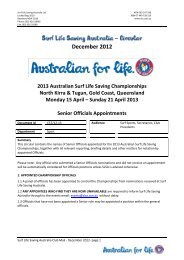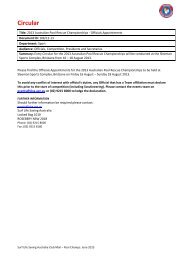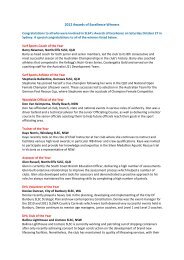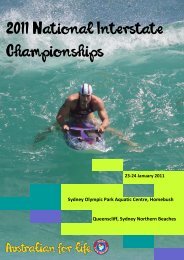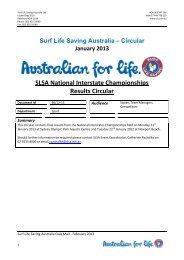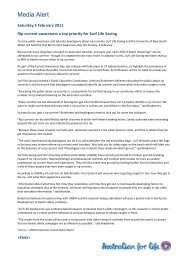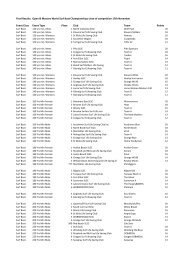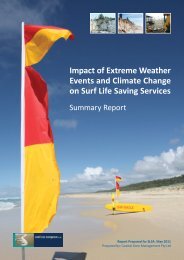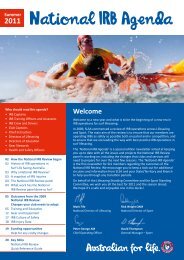SURF LIFE SAVING AUSTRALIA ANNUAL REPORT 2007–08
SURF LIFE SAVING AUSTRALIA ANNUAL REPORT 2007–08
SURF LIFE SAVING AUSTRALIA ANNUAL REPORT 2007–08
- TAGS
- surf
- australia
- annual
- sls.com.au
Create successful ePaper yourself
Turn your PDF publications into a flip-book with our unique Google optimized e-Paper software.
CHIEF EXECUTIVE OFFICER’S <strong>REPORT</strong><br />
I am proud to be part of a team which has the passion,<br />
commitment and intent to propel SLSA into our next century of<br />
saving lives in the water, and to enrich Australia and Australian<br />
lives. I am very confident to say that the best is yet to come.<br />
ANOTHER YEAR OF ACHIEVEMENT<br />
I am very pleased to present a review of operations for<br />
SLSA for the <strong>2007–08</strong> period, my fi rst full fi nancial year as<br />
CEO. As I outlined in last year’s report, SLSA has adopted a<br />
new strategic management plan ‘Saving Lives in the Water’.<br />
Our performance against our targets is outlined and rated in<br />
the preceding pages. This scorecard is critical to ensuring<br />
we are focussed on delivering the broader strategic<br />
direction set out by the Australian Council (the AC, the<br />
‘board’ of SLSA). I believe that the scorecard demonstrates<br />
that we have achieved much—many of the areas previously<br />
rated ‘red’ are now ‘amber’ or ‘green’. Clearly there is<br />
an element of subjectivity in any self-rating assessment<br />
however the scorecard has been reviewed in detail by the<br />
BOM and the AC. Our next step in this process will be to<br />
assign objective key performance indicators (KPIs) to the<br />
various tactics and I look forward to being able to report<br />
on this next year.<br />
GETTING THE BASICS RIGHT<br />
A focus for the last period and for the next is enhancing<br />
our internal management and governance processes.<br />
As with many other organisations, large and small,<br />
we have a number of ‘legacy’ systems and processes,<br />
not all of which lend themselves to streamlined service<br />
delivery to our stakeholders and some of which are<br />
reaching the end of their useful life.<br />
BUILDING SMARTER IT SYSTEMS<br />
An example of this investment in core systems is<br />
the development of a comprehensive information,<br />
communication and technology (ICT) ‘road-map’<br />
for smarter, ‘e’ffi cient systems on and off the beach.<br />
During <strong>2007–08</strong> SLSA commissioned the KAZ Group<br />
to provide a long term ICT strategy on behalf of the<br />
organisation that would:<br />
• Investigate the current major applications and<br />
determine the data used and created.<br />
• Design a central data repository model.<br />
• Investigate reporting requirements of major<br />
stakeholders to ensure the new repository will deliver<br />
improvements to the production of these reports.<br />
• Determine platform architecture options.<br />
• Determine an integration strategy.<br />
This strategy will allow SLSA to:<br />
• Improve the quality and access to data.<br />
• Improve the predictability in ICT budgeting<br />
and outcomes.<br />
• Provide consistent information recording<br />
and reporting across the organisation.<br />
The KAZ report is due in early 2008–09 and a<br />
priority thereafter will be funding these new systems.<br />
With limited resources and many competing priorities,<br />
it is sometimes tempting to underspend on our ‘back end’<br />
systems. However we simply must get the basics right<br />
before we can hope to provide consistent service to our<br />
current stakeholders, both internal and external, as well<br />
as successfully adapt to a changing environment.<br />
ENHANCING OUR CORE INTELLIGENCE<br />
During the period we have devoted signifi cant resources<br />
to improving our intelligence gathering and reporting<br />
processes to help identify in a timely fashion, among other<br />
things, drowning ‘black spots’. This is absolutely critical to<br />
fulfi lling our mission of ‘saving lives in the water’ and is, in<br />
fact, the fi rst strategy identifi ed in our management plan.<br />
Our data is now much more developed in this area and<br />
has provided the evidence base for the development of our<br />
Total Service Plan. This plan is all about developing smarter<br />
lifesaving services and directing them to the area of most<br />
need. For example, a key recommendation of the plan is<br />
to work with state centres to develop intervention plans to<br />
address and eradicate black spots, including the expansion<br />
of frontline services to fi ll any service gaps. This represents<br />
a signifi cant change from the previous ‘organic style’<br />
growth of lifesaving services to evidence-based allocation.<br />
SECTION 02—OVERVIEW OF OPERATIONS AND ACTIVITIES<br />
23



